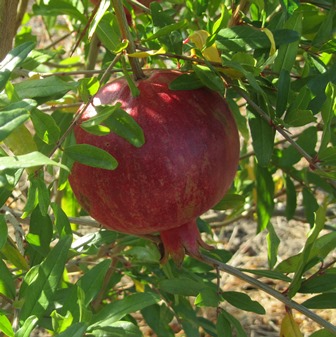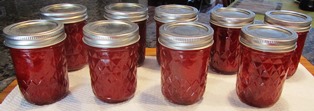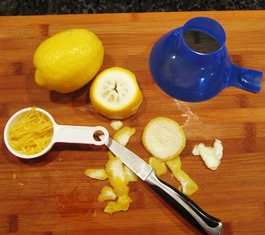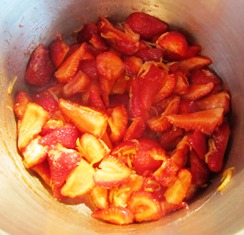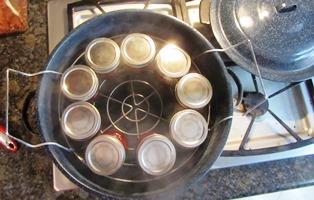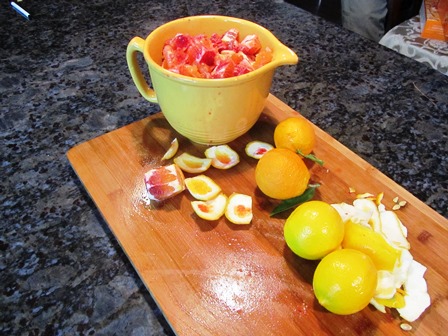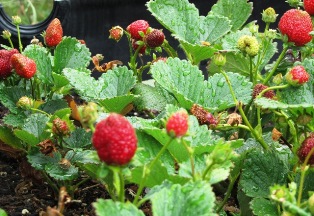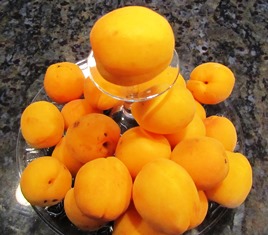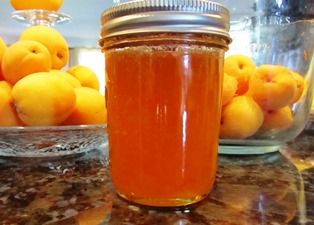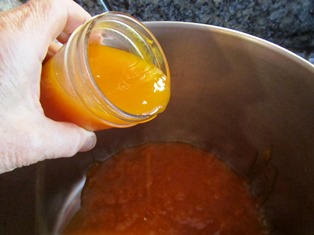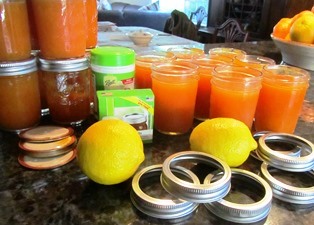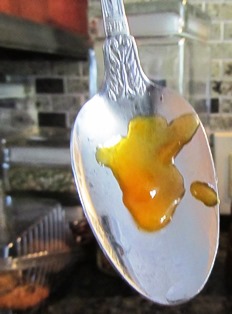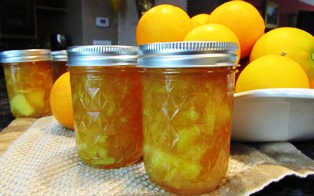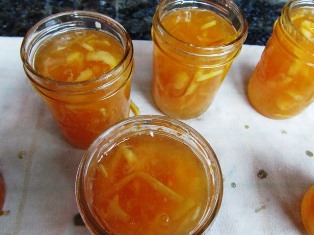Pomegranate Seeds–A Sweet Explosion on the Tongue
Strolling through our small orchard today, I cut into a pomegranate to check on the seeds–the edible part of the fruit. To my surprise, they had turned ripe. Inside, the seeds were gorgeous red jewels, plump and juicy. The sweet juice in the seeds carries a powerful antioxidant punch, too; it’s loaded with Vitamin C, Vitamin K, fiber, potassium, protein, and folate.
You might wonder about ways of cooking with pomegranate seeds. How about tossing them into citrus or a green salad, pairing them with goat cheese on a crostini, or sprinkling a few on poached pears dipped in chocolate, or incorporate them into a Mediterranean couscous with cashews or pistachios?
I think I’ll make some pomegranate jelly–it tastes great on toast, makes an excellent foil for goat cheese, and also creates a moist and delicious glaze for chicken.
The hardest part of making the jelly is separating the seeds from the white pith that holds the seeds in place inside the leathery peel.
The jelly recipe consists of few ingredients: pomegranate juice, sugar, water, and classic pectin. Here’s how I make the jelly.
POMEGRANATE JELLY RECIPE
Ingredients:
3 1/2 cups pomegranate juice (well strained to remove all the particles)
5 cups granulated sugar
6 tablespoons classic pectin
Directions:
Prepare boiling water canner and wash eight to ten half-pint jars in the dishwasher.
Place rings and lids in a pan of simmering hot water.
Cut one end of the pomegranate off to expose the membranes and seeds.
Section the pomegranate and scrape the seeds out into a medium to large bowl.
Repeat the process until you had several cups of seeds.
Rinse well and then run the seeds through a juice extractor.
Strain out the juice through a jelly bag or multiple layers of cheesecloth. Note: The juice stains, so take care to protect kitchen counters and clothing.
Put the juice and pectin into a large pot and bring to a boil, carefully stirring to blend in the pectin.
Add sugar and stir until completely dissolved and boil for one minute at a roiling boil that cannot be stirred down. Ladle off foam, if necessary.
Ladle jam into clean, hot jars leaving one-quarter inch head space. Attach hot lids and then the rings. Tighten to finger tight.
Lower the filled and sealed jars into the canner. Process for 10 minutes at a roiling boil. Remove and let cool.
* * *
If you enjoy reading about farmette topics (including gardening, beekeeping, and delicious recipes), check out my cozy mysteries A BEELINE TO MURDER and also THE MURDER OF A QUEEN BEE in the Henny Penny Farmette series (from Kensington Publishing).
These novels are available through online retailers such as Amazon, Barnes & Noble, Kobo Books, and Walmart as well as from traditional bookstores everywhere.
See, http://tinyurl.com/hxy3s8q
Now available in mass market paperback, this debut novel launched the Henny Penny Farmette series of mysteries and sold out its first press run.
See, http://tinyurl.com/h4kou4g
The second cozy mystery in the Henny Penny Farmette series, available Sept. 27, 2016, is now available on Net Galley (netgalley.com) for professionals and readers who write reviews. The book may be pre-ordered as well. Click on the link under the image.
Simple Strawberry Jam
I visited the Clayton Valley Farmer’s Market on Saturday and picked up six baskets of large strawberries trucked up from Watsonville, about a two-hour drive from my farmette.
Of the various cities claiming to be the strawberry capital of the world, Watsonville surely must rank as number one because it produces tons of berries to support its claim–California produces eighty percent of strawberries in America. Many, if not most, come from Watsonville.
Those berries in the green plastic baskets at the farmer’s market were huge and delicious and sweet. Perfect for making into jam. Strawberry jam, seemingly, is everyone’s favorite, and this year I’m making some extra batches.
The recipe is quite simple, with only five ingredients.
STRAWBERRY JAM
Ingredients:
6 1/2 cups of washed, sliced strawberries (about 2 quarts, plus a little more)
1/4 cup thinly sliced lemon peel
7 1/2 tablespoons powdered pectin
1 tablespoon of lemon juice
6 cups granulated sugar
Directions for Preparing Jars:
Place nine jars in the dishwasher.
Simmer the rings and lids in a skillet on low heat.
Fill the hot-water canner with water enough to cover the jars by two inches. Bring the water to a boil.
Directions to Make Jam:
Slice the lemon peel off and remove any remaining white membrane from the peel.
Slice the lemon peel into thin strips.
Place lemon peel in a small pan, cover with water, and boil for five minutes.
Drain the water off the lemon peel.
In a large pot, combine lemon peel, strawberries, pectin, and lemon juice. Bring to a boil.
Stir in the sugar until it is dissolved and then bring the pot to a roiling boil.
Boil hard for 1 minute, stirring constantly to avoid the jam sticking to the bottom of the pan.
Remove the jam pot from heat and skim off any foam as needed.
Remove the jars from dishwasher and turn upside down on a paper towel. Before filling the jars, wipe around the jar mouth to remove wetness and turn upright to fill.
Ladle the hot strawberry jam into each jar, leaving 1/4-inch head space. Wipe any jam spilled on the jar lip that might void a good seal. Then set the two-piece caps in place and screw tight. Process in the hot-water canner for 15 minutes. Makes 9 jars.
How to Make Marmalade from Blood Oranges
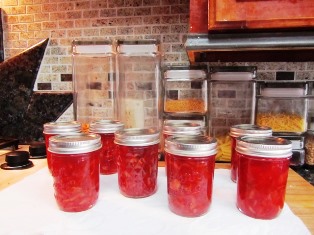
Jars of freshly made blood-orange marmalade are a festive red currant color and perfect for holiday gift-giving
On Christmas Eve this year, I made marmalade from our blood oranges to tuck into our holiday gift baskets.
Our citrus trees are still young and the crop, though ripe, was not yet bountiful. I used almost our entire crop of 20 oranges to make 8 jars (4 ounces each) of the blood orange marmalade.
My recipe is straightforward and the steps are simple. The finished marmalade is a lovely currant color, has a sweet/tangy taste, and possesses an interesting texture made so by the inclusion of rind.
Ingredients:
2 cups orange peel (washed and thinly sliced); roughly 10 medium oranges
1 quart of chopped orange pulp; about 10-15 medium oranges
1 cup lemon (cut into thin slices and seeded); roughly 2 medium lemons
7 cups granulated sugar (the amount of sugar depends on how many cups of citrus mixture you have)
5 Tablespoons of classic pectin
Water to cover the jars by 2 inches for hot water bath processing
Directions:
Place oranges and lemon into a large pot and simmer for 5 minutes.
Remove from heat, cover, and let rest for 12 to 18 hours (I place my citrus mixture in the refrigerator overnight).
Measure by cupfuls the amount of fruit mixture. Add one cup of sugar per cup of fruit mixture.
Over high heat, boil fruit and sugar for approximately 20 minutes, stirring constantly to prevent sticking.
Turn down heat and stir in 5 Tablespoons of classic pectin. Return to boil and stir until mixture thickens and gels when a small amount in placed on a frozen plate.
Remove freshly washed heated jars from the dishwasher.
Simmer lids and rings in shallow pan until ready to use.
Remove from heat and skim off any foam from the jam and then fill the jars, leaving 1/4 inch head space in each jar.
Attach the lids and rings to the jars with a finger tight seal before submerging in the hot water canner of boiling water.
Process jars for 15 minutes before removing them to a place where they can sit undisturbed to cool.
Easy Strawberry-Rhubarb Jam

Rhubarb takes up a lot of garden because of its big leaves but the canes pair well with strawberries
Rhubarb and strawberries just seem to go together. Their flavors blend nicely, whether in a compote, trifle, pie, or jam. The following is a simple recipe for strawberry-rhubarb jam and uses the boiling hot water bath to preserve the jars of jam.
Make extra to tuck into holiday gift baskets or for gift-giving throughout the year.
Ingredients:
2 cups strawberries (washed, hulled, and crushed)
2 cups rhubarb (roughly four stalks, chopped)
1/4 cup lemon juice
6 Tablespoons Classic Pectin
5 1/2 cups sugar
Directions:
Combine the first four ingredients (strawberries, rhubarb, lemon juice, pectin) in a large pot.
Bring to a boil.
Add the sugar, stirring to blend completely.
Return the mixture to a roiling boil.
Time for one minute, stirring constantly.
Remove the pot from heat.
Skim away the foam.
Ladle the jam into hot, clean jars, leaving 1/4 inch head space.
Apply and tighten the two-piece ring/lid caps.
Place jars into the boiling water bath canner.
Process for 10 minutes.
Fixing Jam that Won’t Jell
It happens in jam-making. You do everything right and the jam has a lovely color, flavor, and texture but remains runny long after the jars have cooled following the boiling water process. What to do?
Reprocess the jam in small batches (a quart at a time). A quart of jam fills four (8-ounce jars) or eight (4-ounce jars). Jam needs sugar, pectin, and lemon (acid) to properly jell. A batch I recently made turned out runny and I figured the fruit probably didn’t have enough pectin.
Overripe fruit has lower amounts of naturally occurring pectin whereas unripened fruit has higher amounts of pectin. Go figure!
If the fruit is super ripe (like the lug of apricots I used), the jam will need more pectin to properly jell. It should be reprocessed within 24 to 48 hours. Beyond that time frame, consider other options like using the runny jam as ice cream topping.
The initial step in the reprocessing is to remove the rubber-seal lids and pour all the jam into a pot. Rewash the jars (they will need to be hot when you put jam back into them. You’ll want use new lids, but you can reuse the rings. Heat the rings and new lids with rubber seals in a pot of simmering water.
When the jars are ready to come out of the dishwasher) and the lids are simmering under water in a shallow pan, then prepare the sugar/lemon juice/pectin mixture. Also, place a metal spoon into a glass with water and ice cubes to test the jam after repairing it.
For each quart-size batch of jam, you will need 1/4 cup of sugar, 2 Tablespoons of lemon juice, 4 teaspoons of powdered pectin and about 1/4 cup of water to dissolve everything. Stir well.
Add the sugar/acid/pectin mixture to the runny jam and cook until it reaches a roiling boil, stirring with a long wooden spoon. Boil for one minute. Remove the jam from the heat.
Test the jam for right consistency by placing some onto the stainless steel cold spoon. If it clumps and hangs, not running off, it will jell correctly.
Pour the jam into the hot jars. Wipe the mouths, if necessary to ensure a good seal. Cap each jar with a lid and ring. Process the jars submerged in a boiling water bath for 15 minutes, or according to your recipe.
I’d love to hear from you. Leave a comment letting me know if you’ve tried this process and how it worked for you. Don’t forget to tell me what kind of jam you repaired.
Easy Orange Marmalade
Who can resist the flavors of homemade jams? Whether it embellishes an appetizer of grilled fig and melted goat cheese or is spread upon a fat slice of fresh-baked bread, jam has power to elevate any meal to another level.
Using the seedless oranges growing on our farmette trees, I’m making marmalade. Marmalade made with the oranges ripening this time of year make great additions to holiday gift baskets. I like to add jars of honey, fresh tangerines, nuts, summer jams, and homemade treats.
RECIPE FOR ORANGE MARMALADE
Ingredients:
4 large oranges (preferably a seedless variety)
2 medium lemons
1/2 teaspoon butter (to reduce foaming)
1/8 teaspoon baking soda
6 Tablespoons dry classic pectin
5 1/2 cups sugar
Directions for Preparing the Jars and Canner:
Wash pint jars in the dishwasher or wash the jars and screw rings in hot soapy water, rinse, and drain upside down on paper towels.
Remove the wire rack from the canner and set aside; then, fill the canner half full of water and bring to a simmer.
Directions for Making the Fruit Mixture:
Wash the oranges and lemons.
Peel the fruit, using a vegetable peeler or a sharp paring knife. Discard any seeds and the pithiest parts of the inner peeling as the pith tastes bitter.
Cut the peeled skins into narrow strips.
Pour water into a saucepan.
Add baking soda and strips of peel.
Bring to boil and then reduce the heat, simmering for 20 minutes and stirring as needed.
Cut the fruit into thin quarters.
Add the fruit and juice to the saucepan of simmering peelings, cover, and allow everything to simmer for 10 minutes.
Remove 4 cups of the fruit/peeling/juice mixture and pour into a large saucepan (6 or 8 quart) or stock pot.
Stir in the pectin and add the butter and sugar, mixing well.
Bring to a roiling boil, stirring constantly, for a full minute and then remove from heat, skimming off any foam.
How to Can the Marmalade:
Ladle the fruit mixture into the warm, clean jars, leaving between 1/4 and 1/8 inch space from the top.
Wipe the jar rims before placing the jars on the wire rack of the canner.
Lower the wire rack of jars into the simmering water in the canner.
Make sure the jars are covered by 2 inches of water (add boiling water if necessary).
Cover with lid and boil for 15 to 20 minutes.
Turn off flame, remove the jars of marmalade, and set them onto a towel to cool.
Listen for the popping sound that signals the lids have sealed. Check lids for seal once the jars have cooled by pushing against the center of the lid. If it springs, the jar has not sealed and must be refrigerated. The marmalade will still be good to eat.
 Facebook
Facebook Goodreads
Goodreads LinkedIn
LinkedIn Meera Lester
Meera Lester Twitter
Twitter






